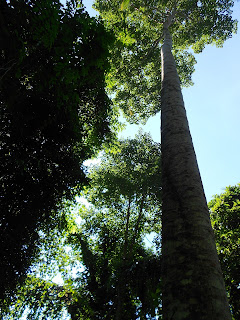Showing posts with label Davao del Sur. Show all posts
Showing posts with label Davao del Sur. Show all posts
Friday, May 10, 2013
On the way to a Rainforest
We went to what I called the secret rainforest in Upper B'la, where the land sloped abruptly down to the Balawanan river about 100 to 200 feet below. I can't be exact about its height. Actually, I can't even tell a foot from a banana, so, don't trust me when I say 200 feet, maybe, it's even higher. But the cliff always had this effect of making me feel breathless as a child, both for its sheer height and for the landscape it offers. It had the same effect on me now.
When I was a child, I remember coming down here with my Pa, seeing the water falling by the steep slopes of the cliff, gushing like little waterfalls. I used to see gigantic bird's nest fern and other giant ferns as big as banana stalks thriving by the wayside. I remember the clear, rushing waters of the Balawanan, the pebbles the color of granite we used to play with. Now, the ferns were almost gone and the river was heavily silted, an island of rocks and debris had formed in the middle. But climbing down this place was such a great moment for me. The gigantic timber trees thriving near the rocky brook that ran its course through the ravines felt as solemn as a cathedral. I would love to come back here over and over again.
Wednesday, January 02, 2013
Aunt's Fantastic Tale
EXCERPT FROM A JOURNAL. November 7, 2007.
Auntie Cora—Corazon Ignacio Lunas—arrived in this part of Mindanao I call B’la from Piddig (pronounced hard as Piddig), Ilocos Norte; a place about as far from Laoag city in Luzon as Bansalan is from Davao city here in Mindanao. (My Aunt wavered in her estimates here, quickly adding, as if to correct herself, “Maybe not Bansalan and Davao city, Day, but Bansalan and Santa Cruz town of Davao del Sur,” she said.)
She was still five years old when she arrived in B’la after the war. Everything was still a forest. She went to school in Grade One, in the first public school set up in B’la among the settlers. The neighbors were just a kilometre away, she recalled. Her classmates were already big, she said, “They were already bayongbayong,” she smiled, referring to boys approaching manhood, “and ulitawo (young men).”
When she reached Grade Three, she returned to Ilocos Norte and came back here at 22, to teach elementary school. Sometime in between, her father opened a kaingin in what is now known as Tagum city in Davao del Norte, the first settler to do so. Unfortunately, he was killed by a fallen tree, so, he was deprived of the fruits of his labor, my Aunt said.
The images she painted to me about B’la at that time bordered on the fantastic: Vegetables like squash, ampalaya and alugbati, just growing by the roadsides, with nobody planting them.
“They just grew wild abundantly in the forest,” my Aunt said. Everywhere in this part was still a forest, she said. Her Uncle Onor would set up a trap for deers and baboy ramo and when they heard an animal scream, they knew they had caught something. “What if they caught a man?” I asked, alarmed.
My Aunt is an Ilocana. She and Ma, who came from Argao, Cebu, are not in any way related except that they spent their whole lives teaching children in B’la (the mythical place where I grew up) and married the cousins from Mambusao, Capiz (my father and my uncle). My Aunt never had the chance to go back to Ilocos Norte since she married and had children (that’s how a place like B’la could tie someone down), so, when my Aunt had a chance for a brief visit up north in 2000, she was already having trouble with the language. She told me she felt she had lost her Ilocano tongue. Almost.
“I had to think first and construct my sentences before speaking,” my Aunt said. “The words no longer come out automatically to me like they used to.”
She said that because there are different variations of Ilocanos spoken in the north, there are already some words she could no longer understand.
Subscribe to:
Posts (Atom)


